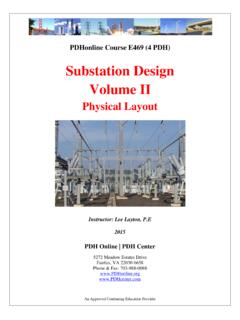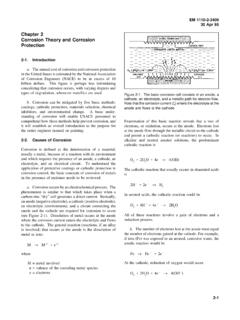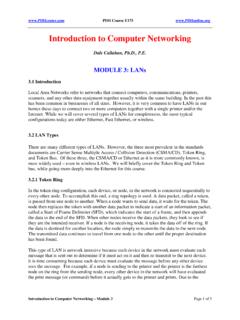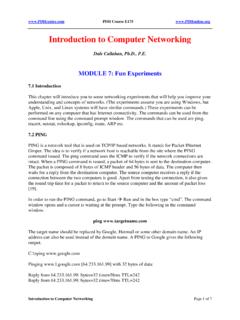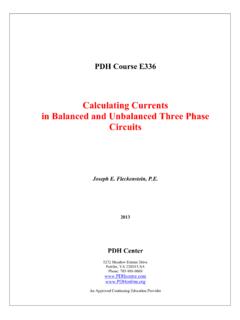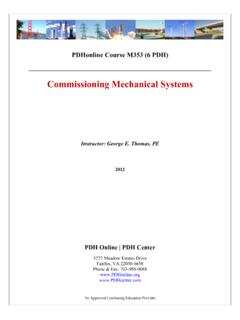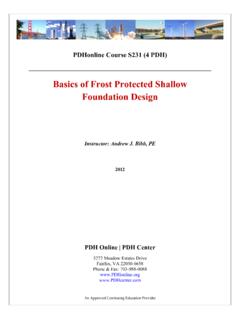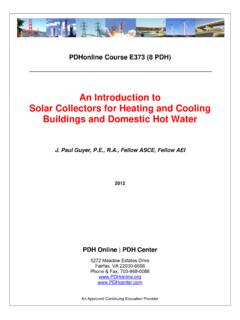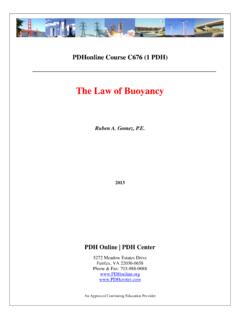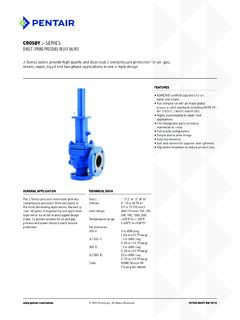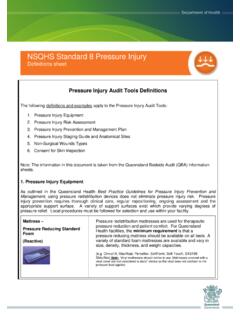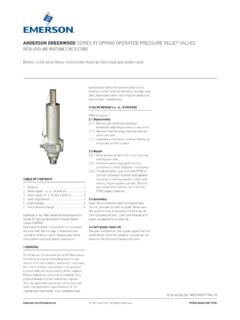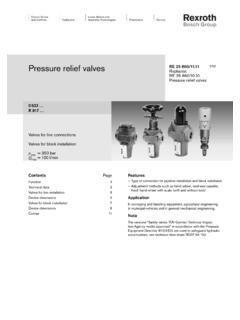Transcription of Selection & Sizing of Pressure Relief Valves
1 PDH Course M112 and Sizing of Pressure Relief ValvesCopyright 2005, 2008 Randall W. Whitesides, and and * (see note on page 2) are numerous types of Pressure -relieving devices and systems, both re-closing andnon-re-closing (rupture discs). This course contains technical information limited to Pressure reliefvalves. The primary purpose of a Pressure Relief valve is the protection of life and property byventing fluid from over-pressurized equipment. Information contained in this course applies to theoverpressurization protection of Pressure vessels, lines, and basic formulae and capacity correction factors contained in this course have been, for the mostpart, empirically developed over time within the valve industry.
2 The material presented reflectscurrent and generally accepted engineering practice. Formulations in this course are consistent withthe requirements of ASME Section VIII, Division 1, and API Recommended Practice and Sizing of Pressure Relief Valves 2005, 2008 Randall W. Whitesides, CPE, PDH Course M112 function of a Pressure Relief valve is to protect Pressure vessels, piping systems, andother equipment from pressures exceeding their design Pressure by more than a fixed,predetermined amount. The permissible amount of accumulation is covered by various codes and isa function of the type of equipment and the conditions causing the accumulation.
3 *It is not the purpose of a Pressure Relief valve to control or regulate the Pressure in the vessel orsystem that the valve protects, and it does not take the place of a control or regulating aim of safety systems in processing plants is to prevent damage to equipment, avoid injury topersonnel and to eliminate any risks of compromising the welfare of the community at large and theenvironment. Proper Sizing , Selection , manufacture, assembly, test, installation, and maintenance ofa Pressure Relief valve are critical to obtaining maximum , Design, and ConstructionA Pressure Relief valve must be capable of operating at all times, especially during a periodof power failure; therefore, the sole source of power for the Pressure Relief valve is the process Pressure Relief valve must open at a predetermined set Pressure , flow a rated capacity at aspecified overpressure, and close when the system Pressure has returned to a safe level.
4 Pressurerelief Valves must be designed with materials compatible with many process fluids from simple airand water to the most corrosive media. They must also be designed to operate in a consistentlysmooth manner on a variety of fluids and fluid phases. These design parameters lead to the widearray ray of Pressure Relief valve products available in the market and Sizing of Pressure Relief Valves 2005, 2008 Randall W. Whitesides, CPE, PE2 NOTE:For ease of learning, the student is encouraged to print the glossary near the end of the course and while studying, refer to the definitions of bold italicized words or phrases when they are first PDH Course M112 1 TWO TYPES OF Relief VALVESThe standard design safety Relief valve is spring-loaded with an adjusting ring for obtaining theproper blowdown and is available with many optional accessories and design features.
5 Refer toFigure 1 for cross-sectional views of typical Valves . The bellows and balanced bellows designisolate the process fluid from the bonnet, the spring, the stem, and the stem bushing with a bellowselement. Jacketed valve bodies are available for applications requiring steam or heat transfermediums to maintain viscosity or prevent freezing. Pilot-operated Valves are available with the setpressure and blowdown control located in a separate control pilot. This type of valve uses the linepressure through the control pilot to the piston in the main Relief valve and thereby maintains a highdegree of tightness, especially as the set Pressure is being approached.
6 Another feature of the pilot-operated valve is that it will permit a blowdown as low as 2 percent. The disadvantage of this typeof valve is its vulnerability to contamination from foreign matter in the fluid and Sizing of Pressure Relief Valves 2005, 2008 Randall W. Whitesides, CPE, PDH Course M112 and StandardsIntroductionSince Pressure Relief Valves are safety devices, there are many Codes and Standards in placeto control their design and application. The purpose of this section of the course is to familiarize thestudent with and provide a brief introduction to some of the Codes and Standards which govern thedesign and use of Pressure Relief Valves .
7 While this course scope is limited to ASME Section VIII,Division 1, the other Sections of the Code that have specific Pressure Relief valve requirements arelisted below. The portions of the Code that are within the scope of this course are indicated in red:List of Code Sections Pertaining to Pressure Relief ValvesSection IPower BoilersSection III, Division 1 Nuclear Power Plant ComponentsSection IVHeating BoilersSection VIRecommended Rules for the Care and Operation of Heating BoilersSection VIIR ecommended Rules for the Care of Power BoilersSection VIII, Division 1 Pressure VesselsAppendix 11 Capacity Conversions for Safety ValvesAppendix MInstallation and Operation Section VIII, Division 2 Pressure Vessels - Alternative Rules , Chapter II, Part 3 Power Piping - Safety and Relief Valves , Chapter II.
8 Part 6 Power Piping - Pressure Relief PipingASME specifically states in Section VIII, Division 1, paragraph UG-125 (a): All Pressure vessels within the scope of this division, irrespective of size orpressure, shall be provided with Pressure Relief devices in accordance with the requirements of UG-125 through UG-137. Selection and Sizing of Pressure Relief Valves 2005, 2008 Randall W. Whitesides, CPE, PDH Course M112 is made to the ASME Boiler and Pressure Vessel Code, Section VIII, Division 1. Theinformation in this course is NOT to be used for the application of overpressurization protection topower boilers and nuclear power plant components that are addressed in the Code in Section I andSection III respectively.
9 The student should understand that the standards listed here are not all-inclusive and that there exist specific standards for the storage of chlorine, ammonia, compressedgas cylinders, and the operation of refrigeration units, among probable Brief History of the ASME CodeMany states began to enact rules and regulationsregarding the construction of steam boilers and Pressure vesselsfollowing several catastrophic accidents that occurred at theturn of the twentieth century that resulted in a large loss of 1911 it was apparent to manufacturers and users of boilersand Pressure vessels that the lack of uniformity in theseregulations between states made it difficult to construct vesselsfor interstate commerce.
10 A group of these interested partiesappealed to the Council of the American Society of MechanicalEngineers to assist in the formulation of standard specificationsfor steam boilers and Pressure vessels. (The American Societyof Mechanical Engineers was organized in 1880 as aneducational and technical society of Mechanical Engineers.) After years of development and publiccomment the first edition of the code, ASME Rules of Construction of Stationary Boilers and forAllowable Working Pressures, was published in 1914 and formally adopted in the spring of this simple beginning, the code has now evolved into the present eleven section document,with multiple subdivisions, parts, subsections.
